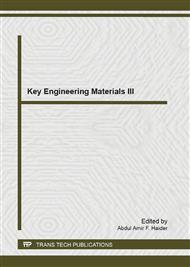p.82
p.87
p.93
p.98
p.103
p.108
p.115
p.120
p.125
Synthesis of VTES/SBA-15 Prepared by Post-Grafting: XRD Characteristics on the Effect of Calcination Properties
Abstract:
Functionalization of Santa Barbara Amorphous-15 (SBA-15) with vinyltriethoxysilane (VTES) via post-grafting method has been synthesized with the effect of calcination time span and temperature range. X-ray powder diffraction has been a means to evident the incorporation of VTES functional groups and to characterize the peak diffraction pattern. The samples of parent SBA-15 have been treated in different calcination temperature and time, ranging from 400°C to 800°C and 2 hr to 8 hr, respectively. The XRD results show that two dimensional p6mm of high order hexagonal mesoscopic structure of VTES/SBA-15 could not be retained at higher temperature of calcination than 700°C. However, the higher time spans of calcination up to 8 hrs preserve the long-range order of functionalized SBA-15.
Info:
Periodical:
Pages:
103-107
Citation:
Online since:
May 2013
Authors:
Price:
Сopyright:
© 2013 Trans Tech Publications Ltd. All Rights Reserved
Share:
Citation:


